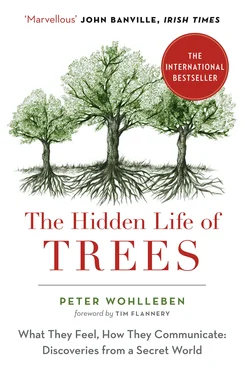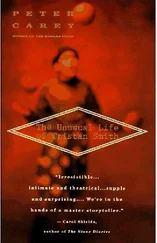But the most astonishing thing about trees is how social they are. The trees in a forest care for each other, sometimes even going so far as to nourish the stump of a felled tree for centuries after it was cut down by feeding it sugars and other nutrients, and so keeping it alive. Only some stumps are thus nourished. Perhaps they are the parents of the trees that make up the forest of today. A tree’s most important means of staying connected to other trees is a “wood wide web” of soil fungi that connects vegetation in an intimate network that allows the sharing of an enormous amount of information and goods. Scientific research aimed at understanding the astonishing abilities of this partnership between fungi and plant has only just begun.
The reason trees share food and communicate is that they need each other. It takes a forest to create a microclimate suitable for tree growth and sustenance. So it’s not surprising that isolated trees have far shorter lives than those living connected together in forests. Perhaps the saddest plants of all are those we have enslaved in our agricultural systems. They seem to have lost the ability to communicate, and, as Wohlle-ben says, are isolated by their silence. “Perhaps farmers can learn from the forests and breed a little more wildness back into their grain and potatoes,” he advocates, “so that they’ll be more talkative in the future.”
Opening this book, you are about to enter a wonderland. Enjoy it.
TIM FLANNERY
INTRODUCTION TO THE ENGLISH EDITION TABLE OF CONTENTS Cover Title Page Copyright Foreword by Tim Flannery Introduction to the English Edition Introduction 1 / Friendships 2 / The Language of Trees 3 / Social Security 4 / Love 5 / The Tree Lottery 6 / Slowly Does It 7 / Forest Etiquette 8 / Tree School 9 / United We Stand, Divided We Fall 10 / The Mysteries of Moving Water 11 / Trees Aging Gracefully 12 / Mighty Oak or Mighty Wimp? 13 / Specialists 14 / Tree or Not Tree? 15 / In the Realm of Darkness 16 / Carbon Dioxide Vacuums 17 / Woody Climate Control 18 / The Forest as Water Pump 19 / Yours or Mine? 20 / Community Housing Projects 21 / Mother Ships of Biodiversity 22 / Hibernation 23 / A Sense of Time 24 / A Question of Character 25 / The Sick Tree 26 / Let There Be Light 27 / Street Kids 28 / Burnout 29 / Destination North! 30 / Tough Customers 31 / Turbulent Times 32 / Immigrants 33 / Healthy Forest Air 34 / Why Is the Forest Green? 35 / Set Free 36 / More Than Just a Commodity Note from a Forest Scientist by Dr. Suzanne Simard Notes Index Acknowledgments About the Publisher
WHEN I WROTE this book, I wanted to describe my experiences in the forest I manage in the Eifel mountains in Germany and record what the trees had taught me. As soon as the German edition of the book was published, it was clear that the story I had to tell struck a chord with many, many people. My message, though grounded in a forest I interact with almost every day, is a message that applies to forests and woodlands around the world.
I am most familiar with the struggles and strategies of beeches and oaks, and with the contrast between deciduous forests that plan their own futures and coniferous forests planted for commercial gain. However, the struggles and strategies in forests left to their own devices, and the tension created when forests are planted instead of evolving at their own pace, are issues that resonate far beyond my experiences in Hümmel.
I encourage you to look around where you live. What dramas are being played out in wooded areas you can explore? How are commerce and survival balanced in the forests and woodlands you know? This book is a lens to help you take a closer look at what you might have taken for granted. Slow down, breathe deep, and look around. What can you hear? What do you see? How do you feel?
My story also explains why forests matter on a global scale. Trees are important, but when trees unite to create a fully functioning forest, you really can say that the whole is greater than its parts. Your trees may not function exactly as my trees do, and your forest might look a little different, but the underlying narrative is the same: forests matter at a more fundamental level than most of us realize.
Before you plunge into this book to find out what I have discovered just by stepping outside my back door, I want to tell you a story about Yellowstone National Park in the United States to show just how vital undisturbed forests and woodlands are to the future of our planet and how our appreciation for trees affects the way we interact with the world around us.
It all starts with the wolves. Wolves disappeared from Yellowstone, the world’s first national park, in the 1920s. When they left, the entire ecosystem changed. Elk herds in the park increased their numbers and began to make quite a meal of the aspens, willows, and cottonwoods that lined the streams. Vegetation declined and animals that depended on the trees left. The wolves were absent for seventy years. When they returned, the elks’ languorous browsing days were over. As the wolf packs kept the herds on the move, browsing diminished, and the trees sprang back. The roots of cottonwoods and willows once again stabilized stream banks and slowed the flow of water. This, in turn, created space for animals such as beavers to return. These industrious builders could now find the materials they needed to construct their lodges and raise their families. The animals that depended on the riparian meadows came back, as well. The wolves turned out to be better stewards of the land than people, creating conditions that allowed the trees to grow and exert their influence on the landscape.
My hope is that the wolves’ stewardship of natural processes in Yellowstone will help people appreciate the complex ways that trees interact with their environment, how our interactions with forests affect their success, and the role forests play in making our world the kind of place where we want to live. Apart from that, forests hide wonders that we are only just beginning to explore. I invite you to enter my world.
INTRODUCTION TABLE OF CONTENTS Cover Title Page Copyright Foreword by Tim Flannery Introduction to the English Edition Introduction 1 / Friendships 2 / The Language of Trees 3 / Social Security 4 / Love 5 / The Tree Lottery 6 / Slowly Does It 7 / Forest Etiquette 8 / Tree School 9 / United We Stand, Divided We Fall 10 / The Mysteries of Moving Water 11 / Trees Aging Gracefully 12 / Mighty Oak or Mighty Wimp? 13 / Specialists 14 / Tree or Not Tree? 15 / In the Realm of Darkness 16 / Carbon Dioxide Vacuums 17 / Woody Climate Control 18 / The Forest as Water Pump 19 / Yours or Mine? 20 / Community Housing Projects 21 / Mother Ships of Biodiversity 22 / Hibernation 23 / A Sense of Time 24 / A Question of Character 25 / The Sick Tree 26 / Let There Be Light 27 / Street Kids 28 / Burnout 29 / Destination North! 30 / Tough Customers 31 / Turbulent Times 32 / Immigrants 33 / Healthy Forest Air 34 / Why Is the Forest Green? 35 / Set Free 36 / More Than Just a Commodity Note from a Forest Scientist by Dr. Suzanne Simard Notes Index Acknowledgments About the Publisher

WHEN I BEGAN my professional career as a forester, I knew about as much about the hidden life of trees as a butcher knows about the emotional life of animals. The modern forestry industry produces lumber. That is to say, it fells trees and then plants new seedlings. If you read the professional literature, you quickly get the impression that the well-being of the forest is only of interest insofar as it is necessary for optimizing the lumber industry. That is enough for what foresters do day to day, and eventually it distorts the way they look at trees. Because it was my job to look at hundreds of trees every day—spruce, beeches, oaks, and pines—to assess their suitability for the lumber mill and their market value, my appreciation of trees was also restricted to this narrow point of view.
Читать дальше













